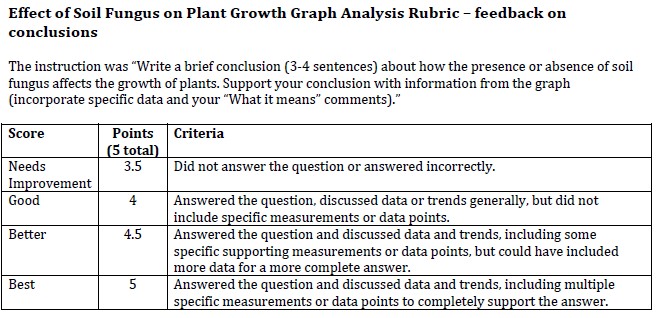Once students have learned how to correctly graph their data, the next step is for them to figure out what that graph is telling them about their data. In past years, I would talk to students about identifying trends, or looking at specific points on the graph, but I didn’t have a very robust lesson on graph analysis. That all changed in the summer of 2017 when my colleague and I went to the Stanford Academy for Excellence in Biology Teaching, a weeklong training offered by the Stanford Graduate School of Education Center to Support Excellence in Teaching (CSET) – whew, that’s a mouthful! The training incorporated a lot of information and strategies from the AP Biology Teacher Academy that was developed in partnership with BSCS, NABT, and HHMI Biointeractive. (If it’s offered in the future, consider doing this course – it was well worth it. I also participated in the year-long follow-up to earn graduate credit from Stanford.)
One of the lessons we learned was the BSCS Identify and Interpret (I2) Strategy. This strategy has students break down their analysis of a graph into two parts. The first is the Identify step, also known as “What I See”. In this step, students are identifying changes, trends or differences. The idea is that they are looking at the big picture, without a lot of specifics. They mark places on the graph where they see a particular change/trend and identify what the change or trend is. The second part is the “Interpret”, or “What It Means” step, where students assign meaning to their “What I See” observations. There is a final step in the BSCS strategy where students write a caption that summarizes the information and where students can demonstrate their understanding of the data. (Instead of having students write a caption, I had them write a supported conclusion.)
I did some direct instruction on the strategy, giving students the BSCS “What I See/What It Means” (WIS/WIM) examples, along with what they were supposed to do for each part of the strategy. Next, we looked at a sample graph – I had the graph projected on the board, so I started with an example where I identified a point, then wrote a WIS statement. I gave students a few minutes to mark their WIS points and make observations. Then I had students come up to the board, identify their WIS point, and wrote a WIS statement on the board. After all of the important points were identified, I wrote an example WIM statement for the WIS point I identified, then gave students time to come up with WIM statements for the WIS points we had on the board. Again, students came to the board and wrote WIM statements that corresponded to the WIM statements.
It seemed like they got it, so I gave students a handout with another graph for practice in the same class period. The handout* included a graph, a grid to write down their WIS and WIM statements, and a third page that gave them room to write a 3-4 sentence conclusion about how the presence or absence of soil fungus affected the growth of plants.


When students finished their graph analysis, I collected the handouts. I wanted to give them a quick turnaround for feedback, so I graded them before the next class session. My feedback focused solely on their written conclusion. The assignment was worth 5 points, so I created a rubric and included student sample answers for each point value so students could see what each criteria looked like.

Honestly, the “What I See” step was the hardest part for my students. They could easily identify points on the graph that seemed to be important, but went right for explaining what it meant. Instead of saying “non-sterilized has a steeper slope compared to sterilized soil” for their WIS statement, they would say something like “plants grew better in non-sterilized soil than sterilized soil”. In general, though, their conclusions were pretty good, especially considering I hadn’t taught them anything about Claim-Evidence-Reasoning yet!


Later in the year, my colleague instructed students that the WIS statement should only identify a point/range on the X-axis and make an observation about what was happening at that point or range. She also instructed students that the WIM statement should describe how the X-axis affects the y-axis. I went back and had students add this information to their earlier notes, and this clarification seemed to help.
All told, this is a great strategy to help students learn how to thoroughly analyze their graphs. I think it helped them write solid conclusions, because they had identified specific parts of the graph that they could then incorporate into their conclusions. If I had reinforced the strategy more throughout the year, students would have been more comfortable with it. My goal for next year is to have a “What I See/What It Means” practice graph for each unit.
*When I print the handout for my students’ notebooks, I print it two sided, with two pages on each side. They can fold the handout in half to make a booklet that fits on one page in their composition book. My colleague joked about me making booklets, but when I taught in public school, I had to buy copy paper myself, so making booklets was an easy way to save paper.
















